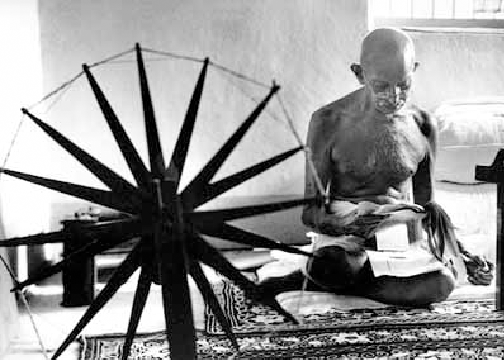MK Gandhi's most 'indelicate' gift for Queen Elizabeth
(and other stories about Khadi)
Former British Prime Minister Winston Churchill had called him 'a seditious middle temple lawyer' posing as a 'half-naked fakir'.

The most iconic image of Mohandas Gandhi shows him bare-chested, clad in a loincloth, and reading a newspaper while seated next to a spinning wheel or charkha. That picture, taken by legendary American photographer Margaret Bourke-White, was shot for the now defunct Time Life Magazine. It was taken in 1946, when Bourke-White arrived in Poona (now Pune), where Gandhi had been imprisoned by the British. Gandhi had taken up spinning to inspire fellow Indians to boycott British goods and buy local produce, including homespun cotton. The photograph went on to become an indelible image, the slain civil disobedience crusader with his most potent weapon.
Former British Prime Minister Winston Churchill had called Gandhi a “half-naked fakir”. He had disparagingly remarked: “Ít is alarming and also nauseating to see Mr Gandhi, a seditious middle temple lawyer, now posing as a fakir… striding half-naked up the steps of the Viceregal palace… to parley on equal terms with the representative of the king-emperor.” The statement was made in 1931, a decade after Gandhi discarded stitched clothes for the loincloth (dhoti) and shawls he sometimes spun himself. It was the year he was invited for tea with Queen Mary and King George V at Buckingham Palace during a visit to London. Dressed in his customary dhoti, a loincloth loosely draped over his naked torso and wearing homemade sandals, he must have been the oddest looking visitor to Buckingham Palace. When the meeting was over, he was walking out of the palace gates when a journalist asked if he thought he was wearing enough. Gandhi’s reply: “But the King was wearing enough for the both of us.”
Former British Prime Minister Winston Churchill had called Gandhi a “half-naked fakir”. He had disparagingly remarked: “Ít is alarming and also nauseating to see Mr Gandhi, a seditious middle temple lawyer, now posing as a fakir… striding half-naked up the steps of the Viceregal palace… to parley on equal terms with the representative of the king-emperor.” The statement was made in 1931, a decade after Gandhi discarded stitched clothes for the loincloth (dhoti) and shawls he sometimes spun himself. It was the year he was invited for tea with Queen Mary and King George V at Buckingham Palace during a visit to London. Dressed in his customary dhoti, a loincloth loosely draped over his naked torso and wearing homemade sandals, he must have been the oddest looking visitor to Buckingham Palace. When the meeting was over, he was walking out of the palace gates when a journalist asked if he thought he was wearing enough. Gandhi’s reply: “But the King was wearing enough for the both of us.”
No comments:
Post a Comment